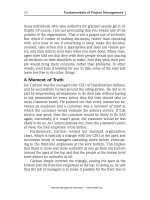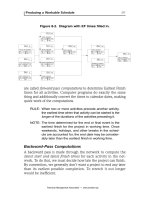Exploring management 6th by schermerhornch11
Bạn đang xem bản rút gọn của tài liệu. Xem và tải ngay bản đầy đủ của tài liệu tại đây (454.16 KB, 38 trang )
Exploring Management
John R. Schermerhorn, Jr. and Daniel G. Bacharach
Sixth Edition
Chapter 11
Leadership
“I have a dream,” said Martin Luther King, Jr, and his voice traveled across generations.
Visionary leaders communicate shared dreams and inspire others to pursue lofty goals.
Copyright ©2018 John Wiley & Sons, Inc.
2
Your Chapter 11 Takeaways
• Understand the foundations of effective leadership. (11.1)
• Identify insights of the contingency leadership theories.(11.2)
• Discuss current issues and directions in leadership development. (11.3)
Copyright ©2018 John Wiley & Sons, Inc.
3
FOUNDATIONS OF LEADERSHIP 11.1
Takeaway 11.1 – answers to come
• Leadership is one of the four functions of management.
• Leaders use power to achieve influence.
• Leaders bring vision to leadership situations.
• Leaders display different traits in the quest for leadership effectiveness.
• Leaders display different styles in the quest for leadership effectiveness.
Copyright ©2018 John Wiley & Sons, Inc.
4
FOUNDATIONS OF EFFECTIVE LEADERSHIP 11.1
The Leadership Function of Management
Leading builds commitments and enthusiasm and turns plans into action.
Figure 11.1 Why is Leading so Important in the Management Process?
Copyright ©2018 John Wiley & Sons, Inc.
5
FOUNDATIONS OF EFFECTIVE LEADERSHIP 11.1
Leaders Use Power to Achieve Influence
• Power is the ability to get others to do
what needs to be done.
• Managerial Power = Position Power × Personal Power.
Copyright ©2018 John Wiley & Sons, Inc.
6
FOUNDATIONS OF EFFECTIVE LEADERSHIP 11.1
Position Power
Position power – what an individual can do based on position in the
organization
Copyright ©2018 John Wiley & Sons, Inc.
7
FOUNDATIONS OF EFFECTIVE LEADERSHIP 11.1
Power
• Personal Power – how the leader is perceived as a person
• Expert power
• special skill or knowledge that influences behavior
• Reference power
• admirable and likeable qualities that influence behavior
Copyright ©2018 John Wiley & Sons, Inc.
8
FOUNDATIONS OF EFFECTIVE LEADERSHIP 11.1
Personal Power
Copyright ©2018 John Wiley & Sons, Inc.
9
FOUNDATIONS OF EFFECTIVE LEADERSHIP 11.1
Leaders Bring Vision
• Vision is a clear sense of the future.
• Visionary leadership is the ability to communicate the vision and how to accomplish
the vision.
Copyright ©2018 John Wiley & Sons, Inc.
10
FOUNDATIONS OF EFFECTIVE LEADERSHIP 11.1
Leadership Traits
• People want leaders who are:
• honest
• competent
• forward-looking
• inspiring
• credible
Copyright ©2018 John Wiley & Sons, Inc.
11
FOUNDATIONS OF EFFECTIVE LEADERSHIP 11.1
Leadership Styles
Figure 11.2 What Are the Classic Leadership Styles?
Copyright ©2018 John Wiley & Sons, Inc.
12
FOUNDATIONS OF EFFECTIVE LEADERSHIP 11.1
Traits of Effective Leaders
Copyright ©2018 John Wiley & Sons, Inc.
13
FOUNDATIONS OF EFFECTIVE LEADERSHIP 11.1
Study Guide for Takeaway 11.1
Rapid Review:
•
Leadership, as one of the management functions, is the process of inspiring others to work hard to
accomplish important tasks.
•
Leaders use power from two primary sources: position power—which includes rewards, coercion,
and legitimacy, and personal power—which includes expertise and reference.
•
The ability to communicate a vision or clear sense of the future is considered essential to effective
leadership.
•
Personal characteristics associated with leadership success include honesty, competency, drive,
integrity, and self-confidence.
•
Research on leader behaviors focused attention on concerns for task and concerns for people, with
the leader high on both and using a democratic style considered most effective.
Copyright ©2018 John Wiley & Sons, Inc.
14
FOUNDATIONS OF EFFECTIVE LEADERSHIP 11.1
Study Guide for Takeaway 11.1
Questions for Discussion:
1.
2.
3.
When, if ever, is a leader justified in using coercive power?
How can a young college graduate gain personal power when moving into a new
job as team leader?
Why might a leader with a human relations style have difficulty getting things done
in an organization?
Copyright ©2018 John Wiley & Sons, Inc.
15
FOUNDATIONS OF EFFECTIVE LEADERSHIP 11.1
Be Sure You Can…for Takeaway 11.1
• illustrate how managers use position and personal power.
• define vision and give an example of visionary leadership.
• list five traits of successful leaders.
• describe alternative leadership styles based on concern for task and concern for
people.
Copyright ©2018 John Wiley & Sons, Inc.
16
CONTINGENCY THEORIES 11.2
Takeaway 11.2 – answers to come
•
Fiedler’s contingency model matches leadership styles with situational differences.
•
The Hersey-Blanchard situational leadership model matches leadership styles with the maturity of
followers.
•
House’s path-goal theory matches leadership styles with task and follower characteristics.
•
Leader-member exchange theory describes how leaders treat in-group and out-group followers.
•
The Vroom-Jago model describes a leader’s choice of alternative decision-making methods.
Copyright ©2018 John Wiley & Sons, Inc.
17
CONTINGENCY THEORIES 11.2
Contingency Leadership Perspective
• Contingency leadership
• Successful leadership varies by the circumstances, task, leader and followers.
• Suggest that what is successful as a leadership style varies according to the
situation and people involved
• Fiedler’s contingency model
• Leadership style depends on the situation.
• Least Preferred Co-worker Scale (LPC)
Copyright ©2018 John Wiley & Sons, Inc.
18
CONTINGENCY THEORIES 11.2
Contingency Leadership
FIGURE 11.3 What Are the Best Matches of Leadership Style and Situation According to Fiedler’s Contingency Model?
Copyright ©2018 John Wiley & Sons, Inc.
19
CONTINGENCY THEORIES 11.2
Hersey-Blanchard
Hersey-Blanchard situational model matches leadership style with maturity of followers.
FIGURE 11.4 What Are the Leadership Implications of the Hersey-Blanchard Situational Leadership Model?
Copyright ©2018 John Wiley & Sons, Inc.
20
CONTINGENCY THEORIES 11.2
Hersey-Blanchard
Hersey-Blanchard Situational Model Matches Leadership Styles with the Maturity of Followers
Delegating—allowing the group to take responsibility for task decisions; a low-task, low-relationship style
Participating—emphasizing shared ideas and participative decisions on task directions; a low-task, high-relationship style
Selling—explaining task directions in a supportive and persuasive way; a high-task, high-relationship style
Telling—giving specific task directions and closely supervising work; a high-task, low- relationship style
Copyright ©2018 John Wiley & Sons, Inc.
21
CONTINGENCY THEORIES 11.2
Path-Goal Theory
House’s Path-Goal theory
•
Help followers move along paths to achieve work and personal goals
Four Leadership Styles in House’s Path-Goal Theory
Directive leader—lets others know what is expected, gives directions, maintains standards
Supportive leader—makes work more pleasant, treats others as equals, acts friendly, shows concern
Achievement-oriented leader—sets challenging goals, expects high performance, shows confidence
Participative leader—involves others in decision making, asks for and uses suggestions
Copyright ©2018 John Wiley & Sons, Inc.
22
CONTINGENCY THEORIES 11.2
Leader-Member Exchange
• Leader-member exchange (LMX)
• In-groups
• Out-groups
Copyright ©2018 John Wiley & Sons, Inc.
23
CONTINGENCY THEORIES 11.2
Vroom-Jago
Vroom-Jago model describes decision-making methods
FIGURE 11.5 What Are the Leadership Implications of the Vroom-Jago
Leader Participation Model?
Copyright ©2018 John Wiley & Sons, Inc.
24
CONTINGENCY THEORIES 11.2
Study Guide for Takeaway 11.2
Rapid Review:
•
Fiedler’s contingency model describes how situational differences in task structure, position power, and
leader–member relations may influence the success of task-motivated and relationship-motivated leaders.
•
The Hersey-Blanchard situational model recommends using task-oriented and people-oriented behaviors,
depending on the “maturity” levels of followers.
•
House’s path-goal theory describes how leaders add value to situations by using supportive, directive,
achievement-oriented, and/or participative styles as needed.
•
Leader–member exchange theory recognizes that leaders respond differently to followers in their in-groups
and out-groups.
•
The Vroom-Jago leader-participation theory advises leaders to choose decision-making methods—authority,
consultative, group—that best fit the problems to be solved.
Copyright ©2018 John Wiley & Sons, Inc.
25









